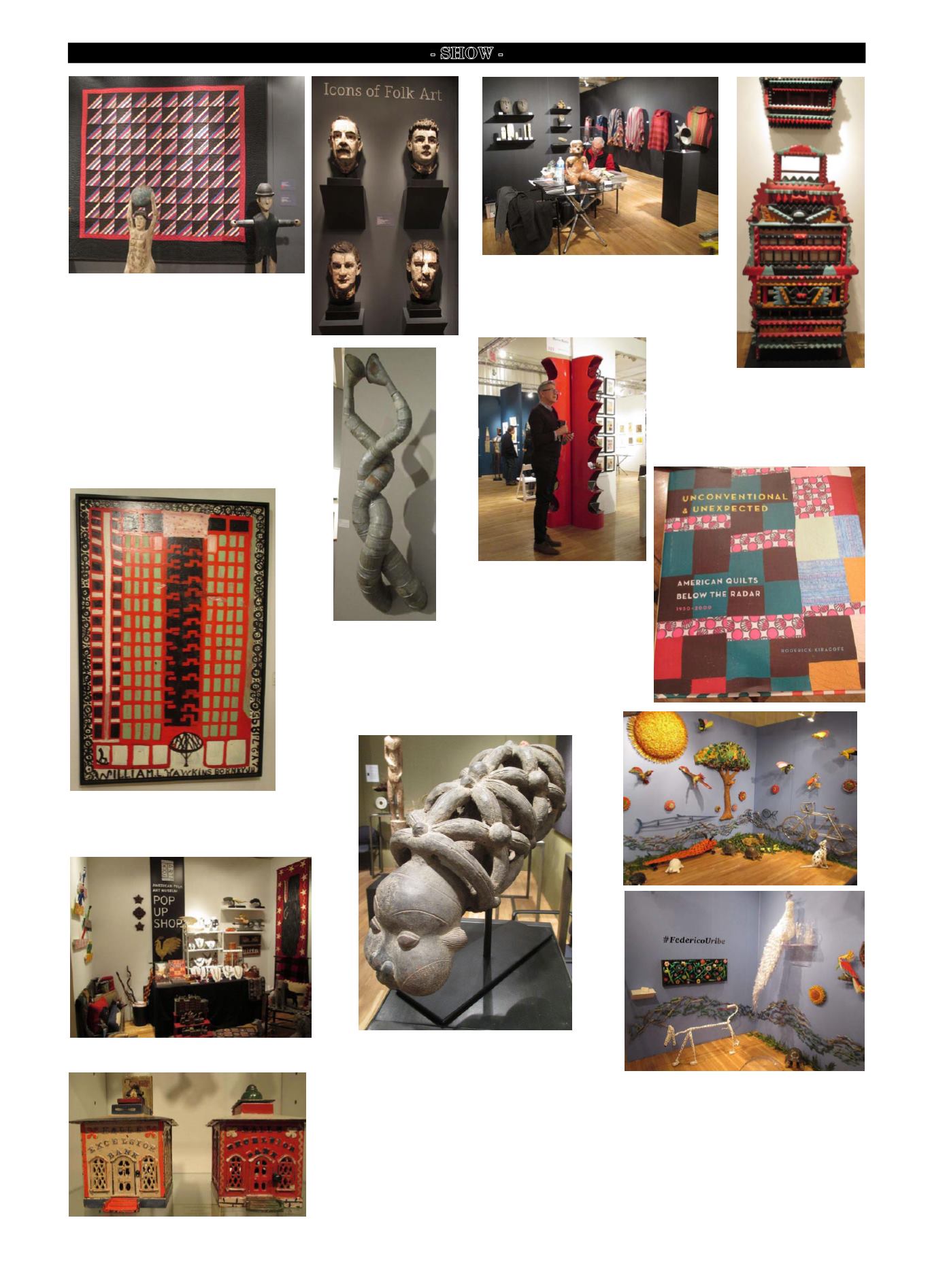

Maine Antique Digest, April 2015 13-D
- SHOW -
This 20th-century earthenware queen mother’s
pipe from the Bamun culture in Cameroon was
$8800 at Douglas Dawson’s booth. The Chica-
go-based ethnographic art dealer’s booth theme
was “Modernist Roots.”
These heads of four men, thought to be portraits of the
founders of a corporation in Albany, New York, are
considered icons of folk art. They were displayed by
Just Folk, Summerland, California. The dealer asked
$225,000 for the anonymous circa 1875 pine heads
with polychrome. The Amish, or possibly Mennonite,
Roman Stripes quilt, made by Mary Yoder, circa 1930,
Holmes County, Ohio, sold. “It’s going to live in the
Houston Museum of Art,” said Susan Baerwald, a
co-owner of the gallery.
Some other sales included a fairground target game
board, circa 1930, English, of hand-painted wood and
metal and a head by Clark Coe (1847-1919) from the
Killingworth assemblage of articulated figures that
were powered by a water wheel in Killingworth, Con-
necticut, 1900-10. The quilt was priced at $6000; the
game board was $13,500; and the head was $12,500,
according to the gallery’s price list.
William Siegal did some last-minute paperwork before
the opening preview of Metro Curates. His booth won
the LongHouse prize for best booth design. By the end
of the show, he had sold pre-Columbian objects and
masks and a textile. “We did phenomenally well,” the
Santa Fe, New Mexico, dealer reported.
Ricco/Maresca Gallery, New York City, dis-
played
Huntington Bank with Parachutist
,
1987, a 72" x 48" oil enamel on masonite by
William Hawkins (1895-1990); it was priced
at $85,000.
This carved chest of drawers
and wall shelf came from an
African-American barber-
shop in West Virginia. Carl
Hammer Gallery, Chicago,
asked $150,000 for it.
Roderick Kiracofe, a curator and
author, displayed some of his quilts at
the booth of The Ames Gallery, Berke-
ley, California. His newest book is
Unconventional & Unexpected: Ameri-
can Quilts below the Radar, 1950-2000
.
He is shown standing in front of Mar-
ion Harris’s booth, waiting for her talk
on “The Art of Collecting.”
The Lovers
, 2010, by Rachel
Selekman (b. 1963, Boston)
greeted showgoers as they
entered Dolan/Maxwell’s booth.
The 51½" x 14½" x 22" sculp-
ture is made from watering can
pieces, roses, epoxy, wire mesh,
buckram, and steel. The Phila-
delphia dealer asked $9500 for it.
Adelson Galleries, Boston, dedicated its booth to Fed-
erico Uribe’s sculptures—trees made from old books
and bookbindings; birds and a wild cat made from bul-
lets; a peacock of plastic forks and spoons; flower beds
of faucets and garden hoses; fish made from paintbrush
handles; and more. A Dalmatian sold and was carried
out the door opening night. Prices were $5000 for the
flowers and bees; $15,000 for the dogs; $18,000 for the
birds made from bullets—one sold; and $40,000 for the
sun, which AdamAdelson said he was close to selling on
the last day of the show. Uribe had a show in 2013 at the
Hudson River Museum in Yonkers, New York.
The American Folk Art Museum’s pop-up shop at
Metro Curates.
These two cast-iron mechanical banks from 1869, made by the
J. & E. Stevens Co., Cromwell, Connecticut, were available at
Leon Weiss’s side of the booth of Gemini Antiques, Oldwick,
New Jersey. The banks were priced at $2000 each. He explained
that he inherited a stamp collection when he was six years old
and went to on to collect model rockets soon thereafter. In the
late ’60s, he came across a cast-iron pull wagon for $5 and sold
the coins to start collecting cast-iron toys. A year later he found
a cast-iron gas pump that cost $12, and he paid for it on lay-
away. He bought his first mechanical bank in 1970 after meet-
ing Connecticut dealer and auctioneer Lloyd Ralston (d. 1996).
☞










